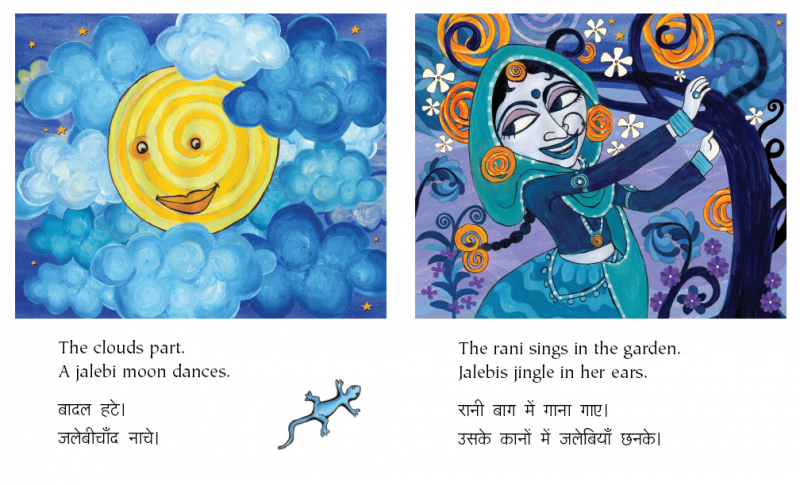Each week, we ask writers, artists, and people of interest to share what’s inspiring them lately. This week we feature picks from writer and professor Amardeep Singh. He teaches literature at Lehigh University and is a former blogger at Sepia Mutiny. You can find him on Twitter or on electrostani.com.
1. The soundtrack to Dhoom 3
2. Tulika Books
 In recent years my time attending art openings, film premiers and happening parties has given way to child-oriented things — changing diapers and obsessively posting baby pictures to Facebook. My wife and I are trying to raise bilingual children, which is not always easy given one’s own linguistic limitations as well as the overwhelming influence of print and visual media in English that sometimes make Hindi or (in our case) Punjabi seem like niche languages. In light of that, bilingual publishers like Tulika books have been a godsend. The books are well-produced and durable (and durability is key with small children), and the titles we own have been really helpful for us as we teach our little ones some Hindi vocabulary.
In recent years my time attending art openings, film premiers and happening parties has given way to child-oriented things — changing diapers and obsessively posting baby pictures to Facebook. My wife and I are trying to raise bilingual children, which is not always easy given one’s own linguistic limitations as well as the overwhelming influence of print and visual media in English that sometimes make Hindi or (in our case) Punjabi seem like niche languages. In light of that, bilingual publishers like Tulika books have been a godsend. The books are well-produced and durable (and durability is key with small children), and the titles we own have been really helpful for us as we teach our little ones some Hindi vocabulary.
3. The School for Good and Evil by Soman Chainani
My older child is not yet ready to read this this young adult besteller by a Desi author, but while I was shopping for titles more appropriate for his reading level I was intrigued to see The School for Good and Evil prominently displayed at my local Barnes & Noble. I’m about 100 pages in, and thus far Soman Chainani’s book is long on fairy tales (with Caucasian protagonists) and short on references to South Asian diaspora type issues. However, Chainani has previously made the short film Kali Ma (which you can see on YouTube here) and his website bio indicates that he’s also working on a film called Love Marriage (any connection to V.V. Ganeshananthan’s novel…?). Hopefully Chainani will bring some of his South Asian diaspora ideas to bear on future young adult projects — that particular space is currently woefully lacking in diversity at present (the young adult aisles at Barnes & Noble are dominated by covers featuring young white women staring off into the distance…). Meanwhile, I wish him continued success with the Good and Evil trilogy.
4. DJ Cheb i Sabbah, Samaya
 The legendary world music DJ and producer Cheb i Sabbah passed away in November 2013. His early CDs on Six Degrees Records were hugely influential in the Asian Underground scene in the late 1990s, and continued to reverberate through the 2000s and 2010s. People new to his music might want to start with Shri Durga (1999) or La Kahena (2005). The benefit album Samaya that was released in 2012 to help Cheb i Sabbah as he was struggling with stomach cancer also has some pretty decent tracks on it. The track “Too Much 21st Century,” which puts Peter Murphy’s vocals from the 1980s goth band Bauhaus over a desi-influenced techno beat, is a standout.
The legendary world music DJ and producer Cheb i Sabbah passed away in November 2013. His early CDs on Six Degrees Records were hugely influential in the Asian Underground scene in the late 1990s, and continued to reverberate through the 2000s and 2010s. People new to his music might want to start with Shri Durga (1999) or La Kahena (2005). The benefit album Samaya that was released in 2012 to help Cheb i Sabbah as he was struggling with stomach cancer also has some pretty decent tracks on it. The track “Too Much 21st Century,” which puts Peter Murphy’s vocals from the 1980s goth band Bauhaus over a desi-influenced techno beat, is a standout.
5. Zadie Smith, NW
Though Zadie Smith’s fourth novel didn’t get as much critical love as some of her earlier, splashier books (the review of NW in the New York Times was respectful and approving, though not quite rapturous), it makes for quite gripping reading. Here Smith is back to the multicultural/multiracial west London world she explored in White Teeth though without the sense of youthfulness that is both the source of that earlier novel’s exuberance as well as its pretty apparent limitations. (White Teeth, in my opinion, has not aged well.) South Asian characters are everywhere in NW, but without a great deal of fanfare or self-consciousness. They appear as old acquaintances as well as store clerks in passing (a Sikh store clerk is introduced simply as “bored”), as well as hip young professional types who are worlds away from the ghettoized and alienated Asian youth rioting in the face of police brutality and racism in Salman Rushdie’s The Satanic Verses. Both the South Asian and black communities in London have changed dramatically since the 1980s, meaning the old identity politics no longer has the purchase it once did. The evolving racial landscape leaves Smith’s black characters somewhat unsure of themselves; arguably Britons of South Asian descent might be facing similar issues.














